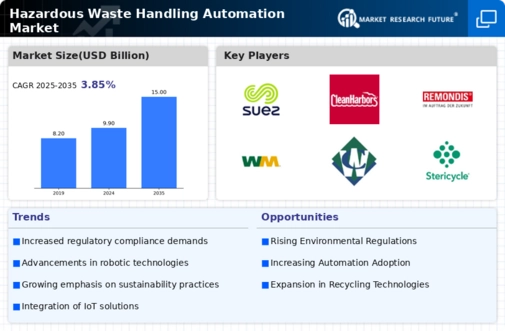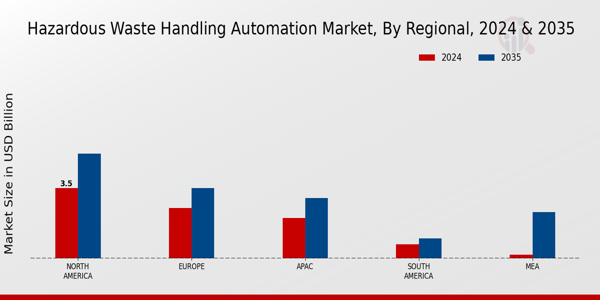Market Growth Projections
The Global Hazardous Waste Handling Automation Market Industry is projected to experience substantial growth in the coming years. With an anticipated market size of 9.9 USD Billion in 2024, the industry is on a trajectory that suggests a significant expansion. By 2035, the market is expected to reach 15 USD Billion, indicating a robust demand for automation solutions in hazardous waste management. The compound annual growth rate of 3.85% from 2025 to 2035 further underscores the industry's potential for growth. This upward trend reflects the increasing recognition of the importance of efficient and safe hazardous waste handling practices across various sectors.
Technological Advancements
Rapid technological advancements are significantly influencing the Global Hazardous Waste Handling Automation Market Industry. Innovations in robotics, artificial intelligence, and IoT are enabling more efficient and safer handling of hazardous waste. For example, automated robotic systems can now identify and segregate hazardous materials with high precision, reducing human exposure to dangerous substances. These advancements not only improve operational efficiency but also enhance safety protocols. As companies increasingly adopt these technologies, the market is expected to grow, with projections indicating a rise to 15 USD Billion by 2035. This growth underscores the critical role that technology plays in transforming hazardous waste management practices.
Increased Industrialization
The ongoing trend of increased industrialization across various regions is a key driver for the Global Hazardous Waste Handling Automation Market Industry. As industries expand, the volume of hazardous waste generated also rises, necessitating more efficient handling and disposal methods. Industries such as manufacturing, pharmaceuticals, and chemicals are particularly notable contributors to hazardous waste production. Consequently, there is a growing demand for automated solutions that can streamline waste management processes. This trend is expected to sustain a compound annual growth rate of 3.85% from 2025 to 2035, as businesses seek to optimize their waste handling operations amidst rising environmental concerns.
Regulatory Compliance Pressure
The Global Hazardous Waste Handling Automation Market Industry is experiencing heightened pressure from regulatory bodies to comply with stringent waste management regulations. Governments worldwide are implementing stricter guidelines to ensure safe disposal and treatment of hazardous materials. For instance, the Environmental Protection Agency in the United States has established comprehensive regulations that necessitate advanced automation technologies for monitoring and reporting waste handling processes. This regulatory landscape is driving investments in automation solutions, as companies seek to avoid penalties and enhance compliance. As a result, the market is projected to reach 9.9 USD Billion in 2024, reflecting the increasing need for automated systems to meet these regulatory demands.
Growing Environmental Awareness
There is a notable increase in global environmental awareness, which is significantly impacting the Global Hazardous Waste Handling Automation Market Industry. Public concern regarding the effects of hazardous waste on health and the environment is prompting both consumers and businesses to prioritize sustainable practices. This shift is leading companies to invest in automated waste handling systems that minimize environmental impact and enhance recycling efforts. Governments are also supporting these initiatives through incentives and funding for green technologies. As a result, the market is poised for growth, with an anticipated increase in demand for automation solutions that align with environmentally responsible waste management strategies.
Economic Incentives for Automation
Economic incentives provided by governments and industry associations are playing a crucial role in the growth of the Global Hazardous Waste Handling Automation Market Industry. Various financial programs and grants are being introduced to encourage businesses to adopt automated waste handling technologies. These incentives not only reduce the initial investment burden but also promote long-term cost savings through improved efficiency and reduced labor costs. As companies recognize the financial benefits of automation, the market is likely to witness a surge in adoption rates. This trend is expected to contribute to the overall market growth, aligning with the projected increase to 15 USD Billion by 2035.






















